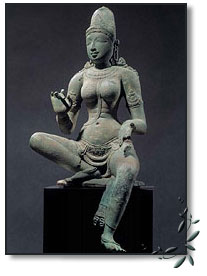
INTRODUCTION:
Introduction by Jan Van Alphen
ESSAY: Cast for Eternity: Essay by Marcel
Nies
| The selection of bronze sacred images in the exhibition Cast for Eternity represents an important reflection of the cultural heritage of India, Sri Lanka, the Himalayas, and China (via Tibet), countries and regions which have occupied their own significant places in the art history of the world for over 2000 years. The sensuality, spirituality and beauty of these images are emphasized by the highly technical development and skilful exploitation of bronze casting techniques. As if they have been created for eternity, the bronzes radiate a sense of immortality and reflect the fascination and mystery of the ancient cultures of Buddhism, Jainism and Hinduism. |
Antwerp, Belgium. Apr 12, 2005 To Jun 26, 2005 |
ESSAY:
Cast for Eternity: Essay by Marcel Nies
INTRODUCTION:
Introduction by Jan Van Alphen
top
all
text & images © 2005 The authors, the photographers and the Ethnographic
Museum, Antwerp


